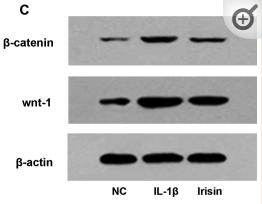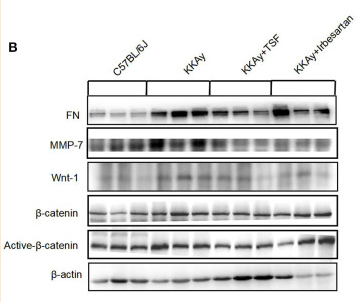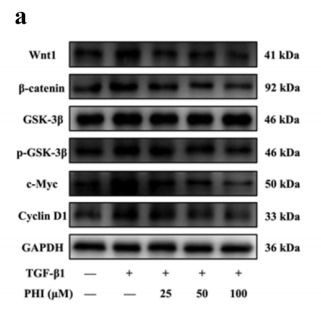Wnt1 Antibody - #AF5315
| Product: | Wnt1 Antibody |
| Catalog: | AF5315 |
| Description: | Rabbit polyclonal antibody to Wnt1 |
| Application: | WB IHC IF/ICC |
| Cited expt.: | WB, IHC |
| Reactivity: | Human, Mouse, Rat |
| Prediction: | Pig, Bovine, Horse, Sheep, Rabbit, Dog, Chicken |
| Mol.Wt.: | 41 kDa; 41kD(Calculated). |
| Uniprot: | P04628 |
| RRID: | AB_2837800 |
Related Downloads
Protocols
Product Info
*The optimal dilutions should be determined by the end user. For optimal experimental results, antibody reuse is not recommended.
*Tips:
WB: For western blot detection of denatured protein samples. IHC: For immunohistochemical detection of paraffin sections (IHC-p) or frozen sections (IHC-f) of tissue samples. IF/ICC: For immunofluorescence detection of cell samples. ELISA(peptide): For ELISA detection of antigenic peptide.
Cite Format: Affinity Biosciences Cat# AF5315, RRID:AB_2837800.
Fold/Unfold
BMND16; INT1; OI15; oncogene Int1; Proto oncogene protein Wnt 1; Proto-oncogene Int-1 homolog; Proto-oncogene Wnt-1; Wingless type MMTV integration site family member 1; wingless-type MMTV integration site family, member 1 (oncogene INT1); Wnt 1; wnt1; WNT1_HUMAN;
Immunogens
A synthesized peptide derived from human Wnt1, corresponding to a region within C-terminal amino acids.
- P04628 WNT1_HUMAN:
- Protein BLAST With
- NCBI/
- ExPASy/
- Uniprot
MGLWALLPGWVSATLLLALAALPAALAANSSGRWWGIVNVASSTNLLTDSKSLQLVLEPSLQLLSRKQRRLIRQNPGILHSVSGGLQSAVRECKWQFRNRRWNCPTAPGPHLFGKIVNRGCRETAFIFAITSAGVTHSVARSCSEGSIESCTCDYRRRGPGGPDWHWGGCSDNIDFGRLFGREFVDSGEKGRDLRFLMNLHNNEAGRTTVFSEMRQECKCHGMSGSCTVRTCWMRLPTLRAVGDVLRDRFDGASRVLYGNRGSNRASRAELLRLEPEDPAHKPPSPHDLVYFEKSPNFCTYSGRLGTAGTAGRACNSSSPALDGCELLCCGRGHRTRTQRVTERCNCTFHWCCHVSCRNCTHTRVLHECL
Predictions
Score>80(red) has high confidence and is suggested to be used for WB detection. *The prediction model is mainly based on the alignment of immunogen sequences, the results are for reference only, not as the basis of quality assurance.
High(score>80) Medium(80>score>50) Low(score<50) No confidence
Research Backgrounds
Ligand for members of the frizzled family of seven transmembrane receptors (Probable). Acts in the canonical Wnt signaling pathway by promoting beta-catenin-dependent transcriptional activation. In some developmental processes, is also a ligand for the coreceptor RYK, thus triggering Wnt signaling (By similarity). Plays an essential role in the development of the embryonic brain and central nervous system (CNS) (By similarity). Has a role in osteoblast function, bone development and bone homeostasis.
Palmitoleoylation is required for efficient binding to frizzled receptors. Palmitoleoylation is necessary for proper trafficking to cell surface (Probable). Depalmitoleoylated by NOTUM, leading to inhibit Wnt signaling pathway (By similarity).
Secreted>Extracellular space>Extracellular matrix. Secreted.
Belongs to the Wnt family.
Research Fields
· Cellular Processes > Cellular community - eukaryotes > Signaling pathways regulating pluripotency of stem cells. (View pathway)
· Environmental Information Processing > Signal transduction > mTOR signaling pathway. (View pathway)
· Environmental Information Processing > Signal transduction > Wnt signaling pathway. (View pathway)
· Environmental Information Processing > Signal transduction > Hippo signaling pathway. (View pathway)
· Human Diseases > Infectious diseases: Viral > Human papillomavirus infection.
· Human Diseases > Infectious diseases: Viral > HTLV-I infection.
· Human Diseases > Cancers: Overview > Pathways in cancer. (View pathway)
· Human Diseases > Cancers: Overview > Proteoglycans in cancer.
· Human Diseases > Cancers: Specific types > Basal cell carcinoma. (View pathway)
· Human Diseases > Cancers: Specific types > Breast cancer. (View pathway)
· Human Diseases > Cancers: Specific types > Hepatocellular carcinoma. (View pathway)
· Human Diseases > Cancers: Specific types > Gastric cancer. (View pathway)
· Organismal Systems > Endocrine system > Melanogenesis.
References
Application: WB Species: Rat Sample: brain tissues
Application: WB Species: Rat Sample: peripheral blood mononuclear cell (PBMCs)
Application: WB Species: Mouse Sample: mHSC
Application: IHC Species: Human Sample:
Application: WB Species: Mouse Sample:
Application: WB Species: human Sample: HUVECs and HA-VSMCs
Restrictive clause
Affinity Biosciences tests all products strictly. Citations are provided as a resource for additional applications that have not been validated by Affinity Biosciences. Please choose the appropriate format for each application and consult Materials and Methods sections for additional details about the use of any product in these publications.
For Research Use Only.
Not for use in diagnostic or therapeutic procedures. Not for resale. Not for distribution without written consent. Affinity Biosciences will not be held responsible for patent infringement or other violations that may occur with the use of our products. Affinity Biosciences, Affinity Biosciences Logo and all other trademarks are the property of Affinity Biosciences LTD.












